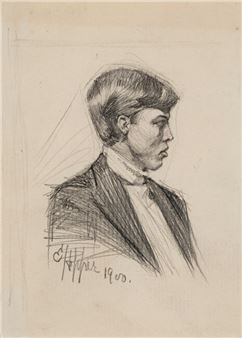The First Homosexuals: The Birth of a New Identity, 1869-1939
The First Homosexuals: The Birth of a New Identity, 1869-1939 explores a sea change in how society regarded homosexuality in the wake of the coining of the term “homosexual” in 1869. Before this watershed moment, same-sex desire marked something you did, not necessarily something you were. The First Homosexuals examines how, for the first time, homosexuals were cleaved from the rest of the population and given an identity which turned on their sexuality. Since the invention of the “homosexual,” sexuality has become totalizing, determining who you are at your core. A little over two years ago while still in the midst of the global pandemic, Wrightwood 659 offered a taste of this upcoming exhibition’s approach and scope in a small preview entitled The First Homosexuals: Global Depictions of a New Identity, 1869-1930.
The forthcoming exhibition is unprecedented with more than 300 works by more than 125 artists from 40 countries, on loan from over 100 museums and private collections across the world, including the Musée d’ Orsay, The Tate, The Courtauld, The Metropolitan Museum of Art, Kunsthaus Zürich, National Museum of Denmark, Fukuoka Asian Art Museum, Pinacoteca de São Paulo, Museo Gregorio Prieto, and the Kinsey Institute for Research in Sex, Gender, and Reproduction, among others. A number of works are national treasures which have never before been allowed to travel outside their countries.

Recommended for you
The First Homosexuals: The Birth of a New Identity, 1869-1939 explores a sea change in how society regarded homosexuality in the wake of the coining of the term “homosexual” in 1869. Before this watershed moment, same-sex desire marked something you did, not necessarily something you were. The First Homosexuals examines how, for the first time, homosexuals were cleaved from the rest of the population and given an identity which turned on their sexuality. Since the invention of the “homosexual,” sexuality has become totalizing, determining who you are at your core. A little over two years ago while still in the midst of the global pandemic, Wrightwood 659 offered a taste of this upcoming exhibition’s approach and scope in a small preview entitled The First Homosexuals: Global Depictions of a New Identity, 1869-1930.
The forthcoming exhibition is unprecedented with more than 300 works by more than 125 artists from 40 countries, on loan from over 100 museums and private collections across the world, including the Musée d’ Orsay, The Tate, The Courtauld, The Metropolitan Museum of Art, Kunsthaus Zürich, National Museum of Denmark, Fukuoka Asian Art Museum, Pinacoteca de São Paulo, Museo Gregorio Prieto, and the Kinsey Institute for Research in Sex, Gender, and Reproduction, among others. A number of works are national treasures which have never before been allowed to travel outside their countries.
Artists on show
- Beauford Delaney
- Berenice Abbott
- Charles Demuth
- Claude Cahun
- Duncan Grant
- Egon Schiele
- Emilio Baz Viaud
- Florence Carlyle
- Florence Henri
- Florence Wyle
- Fred Holland Day
- Frederic Leighton
- Gabriel Morcillo Raya
- George Bellows
- Giovanni Boldini
- Glyn Philpot
- Gustave Moreau
- Harriet Hosmer
- Henri de Toulouse-Lautrec
- Honoré Daumier
- Ismael Nery
- Jacques-Emile Blanche
- Jean Cocteau
- John Singer Sargent
- Katsushika Hokusai
- Kristian Zahrtmann
- László Mednyánszky
- Leon Bakst
- Lionel Wendt
- Manuel Rodríguez Lozano
- Maria Izquierdo
- Marsden Hartley
- Pavel Tchelitchew
- Roberto Montenegro
- Rosa Bonheur
- The Lumière Brothers
- Thomas Anshutz
- Van Leo
Contact details

Related articles
It is a little-known fact that the word homosexual only entered the lexicon in 1869; before that, the concept didn’t exist.
One room over, I could hear my sisters (the lot of us crowded in our too-small travel lodgings) fighting and laughing over a single bathroom mirror, routinely removing the invasion of overnight chin hair.
Assembling 300 works from 40 countries.
Chicago may be the only place to see the ambitious and privately funded exhibition, which disrupts the idea of a gay-straight binary.












